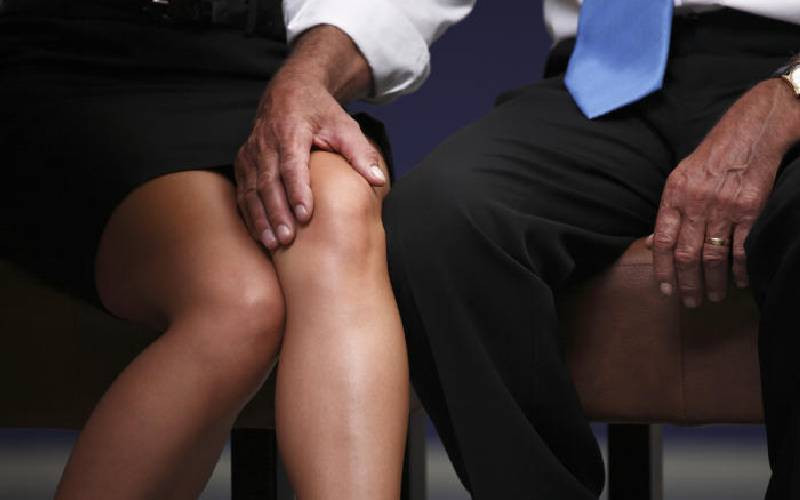
More women in Kenyan media experience sexual harassment compared to male journalists, a new report shows.
The report titled, "The Alarming Prevalence of Sexual Harassment," shows that 60 per cent of women reported sexual harassment compared to male journalists at 23 per cent.
The report commissioned jointly by the Association of Media Women in Kenya (AMWIK) and Thomson Reuters Foundation was released on Tuesday.
The survey was carried out between 2021 to 2023.
Another report titled, "Identifying the Gaps, Limitations, and Effectiveness of Psychosocial and Mental Health Support for Survivors of Sexual Harassment in the Kenyan Media," was also launched.
The sexual harassment report involved 240 participants. It assessed the prevalence of sexual harassment, evaluated the existing legal framework and uncovered the underlying challenges to curbing such harassment.
Of the respondents, 148, were journalists comprising 98 females and 50 males.
Additionally, the study conducted 25 Key Informant Interviews (KIIs) involving 20 journalists and five academics.
Over 70 per cent of the respondents indicated that they knew of perpetrators of sexual harassment who are yet to be punished.
"This stark reality highlights a deeply rooted culture of misogyny and a systemic failure to address sexual harassment effectively," reads the report.
I"The consequence of this culture extends beyond the immediate victims, affecting workplace morale, productivity, and the overall well-being of media professionals as a whole. This crystallises a misogynistic and patriarchal media capture, as female journalists have to endure working in a hazardous space," reads the report.
Of the respondents, 77 per cent said that they did not know of any initiatives that would be powerful enough to dislodge the problem of sexual harassment in their work places.
And 73 per cent indicated that they did not feel empowered or protected enough to report the sexual harassment perpetrators.
According to the research sexual harassment can have significant adverse impacts on the mental health and well-being of the survivors.
Stay informed. Subscribe to our newsletter
The study comes three years after a similar one by WAN-IFRA released in 2021.
The report showed that more women in media houses experienced verbal sexual harassment compared to physical sexual harassment.
The 60 per cent in AMWIK report is an increase from the Women In News report which was at 57 per cent in 2021.
The 2020-21 report also said more men (30 per cent) experienced verbal sexual harassment at 20 per cent.
In the AMWIK study, stigmatization, blame and shame, professional stigma, silencing effect, social isolation led to isolation, self-imposed isolation, workplace isolation, avoidance of reporting and psychological isolation.
On stigmatization for instance, some journalists stated that fear discouraged them from reporting sexual harassment or seeking support.
"They internalised the stigma associated with being a survivor, leading to self-censorship and the suppression of their feelings. Of the respondents, 54.5 per cent said that they did not know of guarantees to anonymity after reporting a case. They therefore preferred to stay silent regarding the sexual harassment rather than get exposed," said Dr Brian Pandiya, assistant researcher.
Lack of comprehensive support, inadequate legal protection, stigma and fear of reprisals, inadequate training, limited accessibility were cited as some of challenges affecting end of the vice.
"Professionals in the media industry, including in human resources and management, lack of training in handling cases of sexual harassment and providing appropriate support to survivors. This knowledge gap hampers effective assistance. Of the respondents, 71.3 per cent indicated that they had never attended a workshop that empowered them to deal with sexual harassment," said Pandiya.
AMWIK acting Executive Director Sharon Kechula, said there is lack of psycho-social support on implementation of policies and lack of awareness among media organisations.
She said that is why the association is working under Kenya Media Sector Working Group (KMSWG) to promote discussions around sexual harassment and how to address it in the sector.
"64 per cent of respondents find current policies insufficient in curbing sexual harassment according to the reports. Under the KMSWG, we already have the model policy and more sensitisation on its uptake is vital," said Kechula.
She said senior managers are the biggest perpetrators of sexual harassment.
Winnie Syombua, gender lead at Journalists for Human Rights(JHR) also said it's time for the media sector and especially all the players in the sector and justice system to work collaboratively to end the sexual harassment.
"From the respondents, it's clear that knowledge of sexual harassment is lacking and even some of perpetrators admitted harassing people unknowingly and therefore awareness is important. There is therefore need for enabling policies in media houses that support routing out the vice," said Syombua.
 The Standard Group Plc is a
multi-media organization with investments in media platforms spanning newspaper
print operations, television, radio broadcasting, digital and online services. The
Standard Group is recognized as a leading multi-media house in Kenya with a key
influence in matters of national and international interest.
The Standard Group Plc is a
multi-media organization with investments in media platforms spanning newspaper
print operations, television, radio broadcasting, digital and online services. The
Standard Group is recognized as a leading multi-media house in Kenya with a key
influence in matters of national and international interest.
 The Standard Group Plc is a
multi-media organization with investments in media platforms spanning newspaper
print operations, television, radio broadcasting, digital and online services. The
Standard Group is recognized as a leading multi-media house in Kenya with a key
influence in matters of national and international interest.
The Standard Group Plc is a
multi-media organization with investments in media platforms spanning newspaper
print operations, television, radio broadcasting, digital and online services. The
Standard Group is recognized as a leading multi-media house in Kenya with a key
influence in matters of national and international interest.





